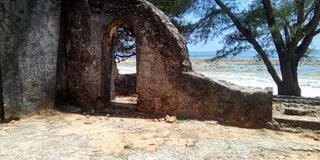Jumba la Mtwana harbours secret of bygone Swahili era

Jumba la Mtwana ruins near Mtwapa Creek off Malindi Road in Kilifi County. It is an ancient stone town set amid shady trees with its former glory captured in the ruins. PHOTO | EUNICE MURATHE | NATION MEDIA GROUP
What you need to know:
- What is known of the ancient town is gathered from ceramic evidence.
- Although many of the structures are no more, it boasts of mosques, a tomb and houses.
- Clearance and excavation of the ruins was first carried out in 1972 by James Kirkman.
- Ten years later in 1982, Jumba la Mtwana was gazetted as a national monument.
Jumba la Mtwana in Mtwapa, Kilifi County, is an ancient stone town set amid shady trees, its former glory captured in the ruins.
The name literally means ‘the large house of the slave’.
According to our tour guide, Mr Ali Makame, there are no written records of the town.
What is known of the ancient town is gathered from ceramic evidence that indicates that the town was built in the 14th century but abandoned in the 15th century.
According to the National Museums of Kenya website, the dating is based on the presence of a few shreds of early blue and white porcelain with lung-chuan celadon, and the absence of any later Chinese wares.
PUZZLE
“Jumba la Mtwana is a puzzle. The history of the place is based on the excavation that was done by archaeologists. It was more than a residential site because it is evident that trading activities took place,” Mr Makame says.
He adds that the inhabitants might have preferred the place due to availability of fresh water and lack of a harbour, which meant enemy ships could not dock.
“In those days, it was very difficult for a large ship to anchor, so the enemy could not attack from sea,” he explains.
COOL AMBIENCE
Although many of the structures are no more, it boasts of mosques, a tomb and houses.
The names of the houses are House of the Cylinder, House of the Kitchen, House of the Many Doors and Mosque by the Sea.
The House of Many Doors is believed to be a guest house that hosted traders from across the Indian Ocean who sailed in dhows propelled by monsoon winds and they would board at the house waiting for the winds to favour them.
A small gallery holds a collection of artefacts such as silver jewellery, boat-making tools, Chinese ceramics and an Arabic oud guitar.
SPERM WHALE
Outside the hall is a large skeleton of a sperm whale, a reminder of trade in ambergris, a secretion in the intestines of the sperm whale used to manufacture perfume.
Trees hang over the ruins, giving it a cool ambience, ideal for picnics.
DESOLATE BEACH
You can walk through the ruins to the desolate beach and an upmarket restaurant.
According to the National Museums of Kenya website, clearance and excavation of the ruins was first carried out in 1972 by James Kirkman with the view of dating the building, its period of occupation and consolidating buildings which were in danger of collapse.
Ten years later in 1982, Jumba la Mtwana was gazetted as a national monument.
Thus, Jumba is legally protected under the Antiquities and Monuments Act Chapter 215 of the laws of Kenya.




